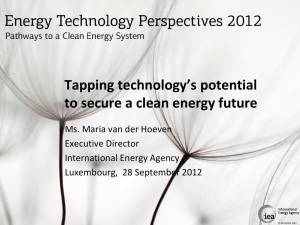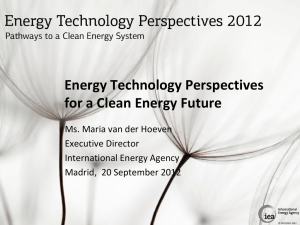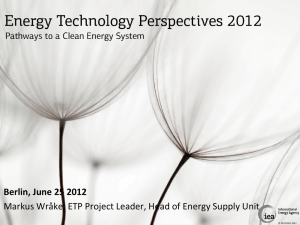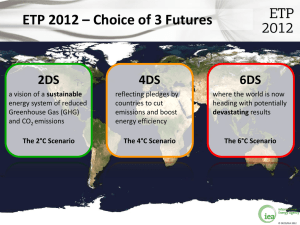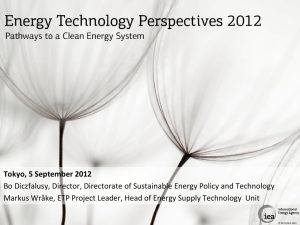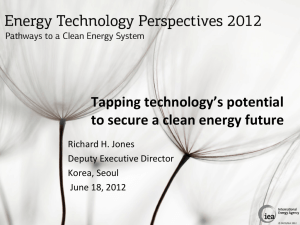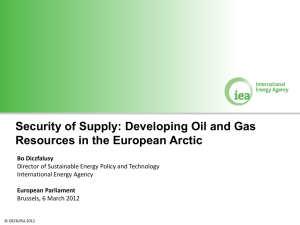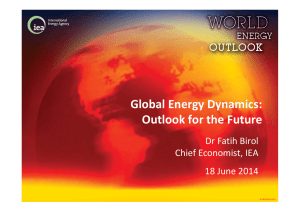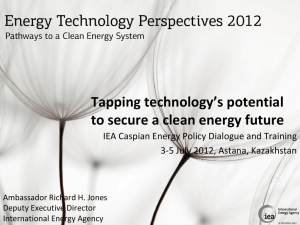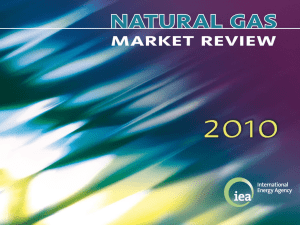PPT
advertisement
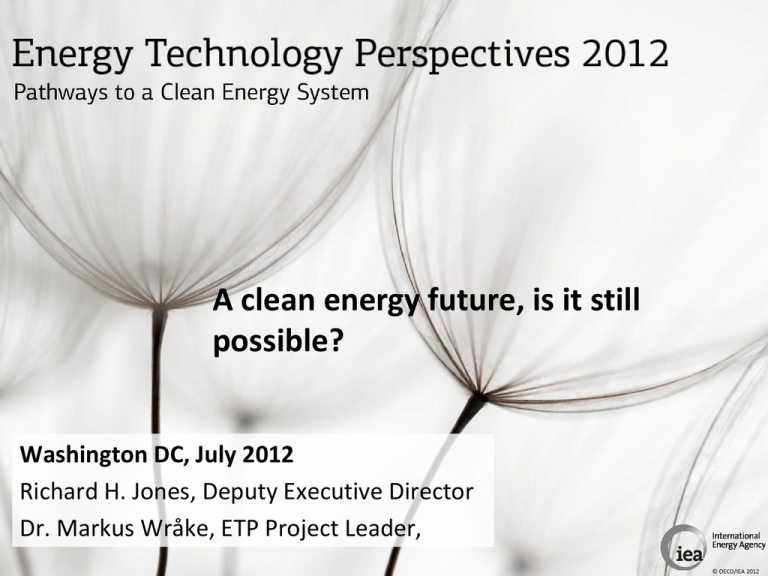
A clean energy future, is it still possible? Washington DC, July 2012 Richard H. Jones, Deputy Executive Director Dr. Markus Wråke, ETP Project Leader, © OECD/IEA 2012 ETP 2012 – Choice of 3 Futures 2DS a vision of a sustainable energy system of reduced Greenhouse Gas (GHG) and CO2 emissions The 2°C Scenario 4DS reflecting pledges by countries to cut emissions and boost energy efficiency The 4°C Scenario 6DS where the world is now heading with potentially devastating results The 6°C Scenario © OECD/IEA 2012 Sustainable future still in reach Is a clean energy transition urgent? Are we on track to reach a clean energy future? Can we get on track? YES ✓ NO ✗ YES ✓ © OECD/IEA 2012 Clean energy: slow lane to fast track Cleaner coal power Nuclear power Renewable power CCS in power CCS in industry Industry Buildings Progress is too slow in almost all technology areas Significant action is required to get back on track Fuel economy Electric vehicles Biofuels for transport © OECD/IEA 2012 Renewables provide good news Renewable power generation 42% 75% 27% Average annual growth in Solar PV Cost reductions in Solar PV in just three years in some countries Average annual growth in wind Energy RD&D has slipped in priority 12% 25 6% 10 4% 5 4 3 2 2% 1 1990 1994 1998 2002 2006 2010 Energy efficiency Fossil fuels Renewable energy Nuclear Hydrogen and fuel cells Other power and storage technologies Other cross cutting technologies/research Share of energy RD&D in total R&D South Africa 1986 Russia 1982 Mexico 1978 India 1974 China 0 0% 0 Brazil USD billion 15 2008 non-IEA country spending USD billion 8% Share of energy RD&D in total R&D 10% 20 © OECD/IEA 2012 A smart, sustainable energy system Co-generation Renewable energy resources Centralised fuel production, power and storage Distributed energy resources Smart energy system control H2 vehicle Surplus heat EV A sustainable energy system is a smarter, more unified and integrated energy system © OECD/IEA 2012 Recommendations to Governments 1. Create an investment climate of confidence in clean energy 2. Unlock the incredible potential of energy efficiency – “the hidden” fuel of the future 3. Accelerate innovation and public research, development and demonstration (RD&D) © OECD/IEA 2012 CO2 reductions in the US 7 6DS emissions 6 Agriculture, other 1% 5 GtCO 2 Other transformation 6% 4 Power 32% 3 Industry 11% 2 Transport 31% 1 0 2009 Buildings 20% 2020 2030 2040 2050 The power and transport sectors are key to achieving the 2DS. © OECD/IEA 2012 Low-carbon electricity: a clean core Global electricity generation in the 2DS 45 000 Other Wind Solar Hydro Nuclear Biomass and waste Oil Gas with CCS Gas Coal with CCS Coal 40 000 TWh 35 000 30 000 25 000 20 000 15 000 10 000 5 000 0 2009 2020 2030 2040 2050 Renewables will generate more than half the world’s electricity in 2050 in the 2DS © OECD/IEA 2012 Rocky road ahead for US renewables GW 10 US wind capacity growth Forecast based on expiration of PTC at end-2012 8 6 Expiration of federal PTC 4 2 0 1998 2000 2002 2004 2006 2008 2010 2012 2014 2016 Policy uncertainty, competition from natural gas and cost of capital slow renewables growth © OECD/IEA 2012 Natural gas is lowering emissions… Gas and coal fired power generation in the US, actual and IEA Medium Term Outlook © OECD/IEA 2012 …but is not a panacea Around 2030, natural gas becomes ‘high carbon’. CCS must play a role if gas use should continue to grow. © OECD/IEA 2012 The CCS infant must grow quickly Mt CO2 Mt CO2 Mt CO2 Mt CO2 Mt CO2 Mt CO2 Note: Capture rates in MtCO2 /year © OECD/IEA 2012 Electric vehicles need to come of age Passenger LDV sales (million) 200 FCEV Fuel Cell Electric Vehicles Electricity 150 Plug-in hybrid diesel Plug-in hybrid gasoline Diesel hybrid 100 Gasoline hybrid CNG/LPG 50 Diesel 0 2000 Gasoline 2010 2020 2030 2040 2050 More than 90% of new light duty vehicles need to be propelled by an electric motor in 2050 © OECD/IEA 2012 Translating targets into action 8 million sales/year 7 Manufacturers production/sales 6 5 Projection (Estimated from each country's target) Projection (Estimated from each country's target) 4 3 2 1 0 2010 2012 2014 2016 2018 2018 2020 2020 Government targets need to be backed by policy action © OECD/IEA 2012 Fuel economy makes a difference PLDV tested fuel economy - WORLD (new car average) PLDV fuel consumption - WORLD [Lge/100km] 10 8 6DS 6 Better FE 4 2 2010 2DS 2020 2030 2040 2050 [billion Lge/year] 2500 6DS equivalent to 11mbbl/day reduction 2000 Better FE 1500 1000 2DS(I/A/S) 500 0 2010 2020 2030 2040 2050 Fuel economy improvements in conventional and hybrid vehicles alone can save 11 mbbl/day. © OECD/IEA 2012 …but modal shift is also needed Billion passenger km Passenger mode share in the US Fuel economy alone is not enough to meet 2DS targets © OECD/IEA 2012 Building sector challenges differ Billion households 2.5 2 1.5 1 0.5 0 2010 OECD 2020 2030 2040 2050 Non OECD 75% of current buildings in OECD will still be standing in 2050 Heating & Cooling: the forgotten giant Renewable heat Integration with electricity District heating and cooling network Co-generation Surplus heat Heating and cooling account for 46% of global energy use. Their huge potential for cutting CO2 emissions is often neglected. © OECD/IEA 2012 Electrification is a double-edged sword Heat pumps can deliver great savings - under the right conditions and with correct operation. © OECD/IEA 2012 Clean energy investment pays off USD trillion Every additional dollar invested in clean energy can generate 3 dollars in return. © OECD/IEA 2012 For much more, please visit www.iea.org/etp © OECD/IEA 2012 Visualising ETP Data – reductions © OECD/IEA 2012 Visualising ETP Data – energy flows © OECD/IEA 2012 Visualising ETP Data – fuel flows © OECD/IEA 2012
